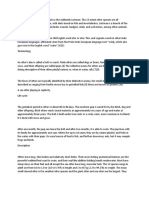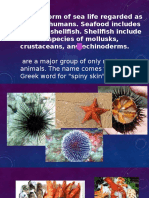Ocean Facts: Clever Creatures
Ocean Facts: Clever Creatures
Uploaded by
SvedenborgCopyright:
Available Formats
Ocean Facts: Clever Creatures
Ocean Facts: Clever Creatures
Uploaded by
SvedenborgOriginal Description:
Original Title
Copyright
Available Formats
Share this document
Did you find this document useful?
Is this content inappropriate?
Copyright:
Available Formats
Ocean Facts: Clever Creatures
Ocean Facts: Clever Creatures
Uploaded by
SvedenborgCopyright:
Available Formats
OCEAN FACTS
Clever creatures Dolphins belong to a group of whales called toothed whales. They do not eat plankton but hunt squid and fish. Dolphins are very intelligent creatures. They communicate with each other using different sounds arranged like words in a sentence. Some dolphins are very rare. The shepherds beaked whale is a recent discovery. Dolphins are social animals. They live in family groups. If one dolphin is sick or injured, others will come to its rescue. Dolphins are mammals. They breathe air and feed their babies with milk. The bouto is a dolphin that lives in the Amazon River. The bottle-nosed dolphin lives near coasts where it feeds on fish and prawns. A narwhals front tooth grows to form a tusk up to 2.5 metres long. The largest whale with teeth is the sperm whale which reaches 20 metres in length. Sperm whales hunt squid and fish in deep waters, diving down 500 metres to find food.
Deadly creatures Sharks and rays are found in all seas. Their skeletons are made of soft cartilage instead of hard bone. Sharks hunt other sea creatures, using their sharp teeth and strong muscles to overpower their prey. The largest shark is the 18-metre long whale shark. Unlike most sharks, it does not hunt other animals. Instead, it feeds on plankton. The harmless whale shark lives in warm waters. The largest hunting shark is the great white shark. It may grow to 7 metres long and usually feeds on larger fish and other animals. The great white shark sometimes attacks people.
Receptors on the head of the hammerhead shark help it to detect its prey. It swings its head from side to side as it swims. The manta is a giant ray. Its wings can measure 7 metres across. Sometimes it jumps out of the sea, creating a large splash when it falls back. The thresher shark uses its long tail to beat the water when hunting. Experts think that this may stun fish, making them easy to catch. Large groups, called mobs, of blue sharks are often found in tropical oceans. As many as a thousand blue sharks may form one mob. The stingray has a large, poisonous spine on top of its tail, which it uses to fight off attackers.
Flying creatures Many birds live at sea feeding on fish or other sea creatures. Most seabirds nest on islands, where their eggs and young are safe from attack. Seabirds often make long journeys between their nesting sites and feeding grounds. Arctic terns travel between the Arctic and the Antarctic. Herring gulls are very common. They feed on fish and shrimps, but will also fly inland to raid rubbish dumps and picnic areas. The great skua is a large bird, over 50 cm long. It hunts other seabirds, as well as fish. A skimmer finds fish by flying just above the surface of the sea, with its bill in the water. As soon as the bill strikes a fish, it is snapped up. The largest seabird is the wandering albatross, which has wings 3.5 metres across. Long ago, sailors believed it was bad luck to kill an albatross. Steamer ducks live around the coast. They cannot fly, but swim along the shore looking for shellfish, shrimps and crabs to eat. Puffins nest on cliffs and rocky islands. The females lay just one egg each year. Gannet fly around searching for fish in the water. They may dive from a height of 30 metres to catch their prey.
Strange creatures There are many fish in the oceans that look strange to us, but they are actually very well adapted to their surroundings. Thousands of fish have evolved to live in different places on coral reefs, in icy waters, near the surface of the sea, or on the seabed.
The four-eyed fish swims at the surface with each of its two eyes half in and half out of the water. The fish looks for insect prey on the surface, while watching for danger under the sea. Flying fish are able to leap out of the water and glide through the air, using their fins as wings. It is thought that the fish fly in this way to escape hunters. When danger threatens, the porcupine fish gulps huge amounts of water and swells up to four times its usual size. The stiff spines stick out to make the fish look like a spiky football. The swordfish has a bony upper jaw, which can be over 1 metre long and shaped like a sword. Nobody knows what the sword is used for. The sailfish is the fastest fish in the sea. It can reach speeds of 110 kilometres per hour. The coelacanth lives in the deep waters of the Indian Ocean. Before one was caught in 1938, the coelacanth was known only from fossils dating back 60 million years. Scientists thought it had been extinct ever since. The sea dragon is only 40 cm long. It swims near seaweed where it can hide easily.
Prehistoric creatures Millions of years ago, strange creatures lived in the oceans. Scientists know about these creatures because they have found fossils of their bones buried in ancient rocks. Many of these giant sea animals lived before or at the same time as the dinosaurs. Archelon was the largest turtle. It was nearly 4 metres long and lived about 70 million years ago. Kronosaurus had the largest head of any hunter in the sea. It was almost 3 metres long and was armed with lots of sharp teeth. Cryptocleidus had strong flippers to propel it through the water. It caught small fish in its long jaws armed with dagger like teeth. Ichthyosaurus looked like a dolphin or large fish, but was really a reptile. Ichthyosaurus could not come on shore to lay eggs like most reptiles, so it gave birth to live young, as does a mammal. Nothosaurus was one of the first reptiles to live in the sea. It lived in the waters that covered what is now Europe about 210 million years ago. Tanystropheus lived on the coast. It dipped its long neck into the water and snapped up fish and shrimps. Placodus lived about 200 million years ago in Europe. It ate shellfish and used its webbed feet to help it swim.
Metriorhynchus was a 3-metre long crocodile, which lived in the ocean 140 million years ago. It was so adapted to life in the sea that it even had a fish-like tail.
Mysterious creatures Because the oceans are so vast there are many areas which have never been properly explored. Sailors who have travelled off the main shipping routes have reported seeing strange and curious creatures. As nobody has ever caught one of these mysterious creatures, scientists do not believe they really exist. The type of sea monster most often seen has a small head and a long neck held upright. Witnesses say they see a large body under the water with four large fins which move the creature slowly along. This sea monster looks like a prehistoric sea animal, elasmosaurus, which was about 10 metres long. The 4-metre long megamouth shark was not discovered until the 1980s. Nobody knew about it until one was accidentally caught in a net. This proved that large sea creatures can exist without anybody knowing about them. Long ago, sailors believed in mermaids. Today, scientists know that what they probably saw were seal-like creatures called manatees. Manatees swim slowly in shallow coastal waters, feeding on water plants. The sea serpent is supposed to be a gigantic, snake-like creature up to 30 metres long. Many people have reported seeing them. A giant turtle-like creature was seen in 1877 by the crew of HMS Osborne. The creature was about 20 metres long and swam quickly.
Monsters of the sea Some of the strangest monsters can be found swimming and living in the sea. Large ones like the whales and sharks swim in the open ocean. Others, like giant sponges, hide deep down on the seabed. Lurking at the bottom of the sea near Japan are giant spider crabs. With their claws outstretched they can measure nearly three metres. The suckers on a 15-metre giant squid measure 10 cm across. But sucker scars on whales have been seen as long as 45 cm! Trailing deadly poisonous tentacles, Arctic giant jellyfish drift in the northern seas. Their tentacles can reach down over 30 metres. Sharks can detect vibrations and electricity given out by injured creatures over long distances. Some can even taste blood. Loggerhead sponges can be a metre high and a metre across.
Walruses are huge, bulky animals. They have bristly whiskers to help them find their food on the seabed. Their huge tusks are used to haul themselves out of the water. Weighing about 150 tonnes, the blue whale is the worlds largest mammal. A blue whale can hold over a tonne of water in its mouth. Deep-sea fish are fierce hunters with wide gulping mouths and long fangs. The tiger shark with its sharp teeth is a fierce predator in the sea. Vikings Viking raids were carried out by warriors in longships. As many as 100 longships would take part in a single raid. The Vikings would land, capture as much money, food, cattle and valuables as possible and sail away again. Longships were narrow boats, which could be up to 30 metres in length. They were not very heavy and were very quick through the water as they had oars as well as a large sail. Some longships had dragon heads carved on to them to make them look fiercer. Viking warriors believed that when they died they would go to Valhalla, the banquet hall of the gods. Viking chiefs and famous warriors would often be buried with their boats and their favourite possessions when they died. Sometimes the body would be placed on the deck of the boat and burned. Sea and Sailing Ships and boats are very old inventions. Archaeologists think that people first made journeys in small boats 50,000 years ago. The boats were very simple canoes carved from tree trunks. Ships and boats are not only used for transporting people, but for trade, too. Today, most of the goods traded between different countries are sent by ship. Archaeologists dont really know when sailing boats were invented. However, the Ancient Egyptians sailed boats made of reeds along the River Nile over 5,000 years ago. These reed boats had square sails. A triangular sail, called a lateen sail, was invented around 300 BC. Boats with lateen sails could sail where their crews wanted them to. A type of boat called a dhow has a lateen sail. In the 1400s full rigging was developed. Full-rigged ships had two or three masts with square and triangular sails. In the 1400s and 1500s European explorers, such as Christopher Columbus, sailed small full-rigged ships across the oceans. Soon after small portable steam engines were invented engineers built steam-poweredboats. The Charlotte Dundas was built in 1801. The engine turned large paddle wheels, which pushed the boat through the water. A hydrofoil has wings, which lift it out of the water. The reduced friction means it can go much faster than ordinary boats. The idea for the hydrofoil was thought of in 1881. However, the first hydrofoil was not tested until 1905. A hovercraft is half boat, half aeroplane. It skims across sea or land on a cushion of air. The first practical hovercraft was launched in 1959. Most modern ships are pushed along by a propeller. It was patented in 1836 and soon replaced paddle wheels.
Communication at Sea The semaphore system was the first way of communicating over long distances. Semaphore stations were positioned on hilltops, and the message was passed from one station to the next. The system was first used in France in 1794. The message was shown by moving the arms on top of the semaphore station to different positions. Radio was first used in the 1890s. Sailors used it to send signals to the shore by Morse code. The first radio programme was broadcast in 1906. Mysterious disappearances Throughout history there have been reports of people vanishing without trace. Ships and aeroplanes seem to have disappeared into thin air! Some of these cases are still shrouded in mystery. Sometimes stories have been made up to explain disappearances. When famous band leader, Glenn Miller, vanished in 1944, some people believed that his face had been so disfigured in a plane crash that he had decided to hide away for the rest of his life. In 1872 the entire crew of the merchant ship, the Mary Celeste, vanished. The ship was completely undamaged but no one on board was ever seen again. The crews meal was found half-eaten on the table. Often disappearances are hoaxes. In 1880, the story of a farmer who had apparently vanished hit the headlines in Tennessee, USA. It turned out that a hardware salesman, who had been snowed into his house, had invented the whole story out of boredom! In 1937, Amelia Earhart, a record-breaking pilot, disappeared en route to an island in the Pacific Ocean. No one has ever been able to explain this mysterious disappearance. Over the years, ships and aeroplanes have vanished in the Bermuda Triangle, without trace of any wreckage. In 1880, a ship called the HMS Atlanta disappeared together with 290 crew members. Second sight In 1889, Morgan Roberts wrote The Wreck of the Titan. It tells the story of a massive luxury liner, called the Titan, which hit an iceberg and sank. The Titanic did exactly that 14 years later and more than 1,500 of the passengers were drowned. More spooky cases The Flying Dutchmanwas a ship, which sank in the 1600s. Its ghost is said to haunt the oceans. In 1881, the crew of HMS Inconstant thought they saw the ship. In 1939, over 100 people claimed to have seen the ship as they sunbathed on a beach near Cape Town, South Africa. During World War II, a German admiral reported that the crew of a U-Boat submarine had seen the phantom ship. In 1911, the crew of the steamer, Orkney Belle, encountered The Flying Dutchman. It was totally deserted. It is said that three bells were heard and the ghost ship vanished into the fog.
You might also like
- The Biggest Monsters That Ever Swam The Seas: Feature Story 1255Document6 pagesThe Biggest Monsters That Ever Swam The Seas: Feature Story 1255nikhilpoyyara87No ratings yet
- ProjectDocument5 pagesProjectAbid ShaikhNo ratings yet
- Lecture 1: SHARKS: Corresponding Reading Material Shark Section in Lab Manual Levinton: Chapter 8Document15 pagesLecture 1: SHARKS: Corresponding Reading Material Shark Section in Lab Manual Levinton: Chapter 8JelenaNo ratings yet
- SharksDocument3 pagesSharksFilippo RinaldiNo ratings yet
- Sea Animals WKSDocument7 pagesSea Animals WKSBianca CardozoNo ratings yet
- OTTERSDocument6 pagesOTTERSMiguel LleraNo ratings yet
- Year 5 6 Weird and Wonderful Marine LifeDocument3 pagesYear 5 6 Weird and Wonderful Marine LifewhiteswandiariesNo ratings yet
- Amazing Shark FactsDocument5 pagesAmazing Shark FactsRahul JoshiNo ratings yet
- Monsters That Used To Live in The SeaDocument3 pagesMonsters That Used To Live in The Sealynseyormerod5No ratings yet
- Marine Life Text - EC 6th GRADEDocument2 pagesMarine Life Text - EC 6th GRADEwhiteswandiariesNo ratings yet
- Sua Portillo - Final Creature ReportDocument3 pagesSua Portillo - Final Creature Reportapi-524398672No ratings yet
- Sharks Fact SheetDocument2 pagesSharks Fact SheetEric SNo ratings yet
- Class of FishDocument15 pagesClass of FishMa Cel GeotoroNo ratings yet
- The Killer WhaleDocument10 pagesThe Killer Whaleapi-269897268No ratings yet
- Why Are Flamingos Pink?: Questions and Answers About Amazing AnimalsFrom EverandWhy Are Flamingos Pink?: Questions and Answers About Amazing AnimalsNo ratings yet
- Just Keep Swimming! Fish Book for 4 Year Olds | Children's Animal BooksFrom EverandJust Keep Swimming! Fish Book for 4 Year Olds | Children's Animal BooksNo ratings yet
- Underwater World: Nooramirul Azmi Bin JamilDocument14 pagesUnderwater World: Nooramirul Azmi Bin JamileyuyazmiNo ratings yet
- What Do We Know About Animals? Life in the Seas: WHAT DO WE KNOW ABOUT ANIMALS?, #2From EverandWhat Do We Know About Animals? Life in the Seas: WHAT DO WE KNOW ABOUT ANIMALS?, #2No ratings yet
- My First Book about the Alphabet of Coastal Animals: Amazing Animal Books - Children's Picture BooksFrom EverandMy First Book about the Alphabet of Coastal Animals: Amazing Animal Books - Children's Picture BooksNo ratings yet
- The Shark That Walks On Land: and Other Strange But True Tales of Mysterious Sea CreaturesFrom EverandThe Shark That Walks On Land: and Other Strange But True Tales of Mysterious Sea CreaturesRating: 4.5 out of 5 stars4.5/5 (3)
- Some Facts About Shark1Document2 pagesSome Facts About Shark1Atique Naveed BajwaNo ratings yet
- Understanding Life Below the Beautiful Sea | Children's Fish & Marine LifeFrom EverandUnderstanding Life Below the Beautiful Sea | Children's Fish & Marine LifeNo ratings yet
- Aquatic MammalsDocument4 pagesAquatic MammalsNarasimha MurthyNo ratings yet
- By-Smit Patel Humanities - 145Document9 pagesBy-Smit Patel Humanities - 145Smit Patel100% (1)
- Tahap-Tahap Evolusi IkanDocument11 pagesTahap-Tahap Evolusi IkanGunawan Muhammad100% (1)
- Turtles The Ultimate Turtles Book: Discover the Shelled World of Turtles & TortoisesFrom EverandTurtles The Ultimate Turtles Book: Discover the Shelled World of Turtles & TortoisesNo ratings yet
- My First Book about Sharks: Amazing Animal Books - Children's Picture BooksFrom EverandMy First Book about Sharks: Amazing Animal Books - Children's Picture BooksNo ratings yet
- Frogs, Sharks, WhalesDocument8 pagesFrogs, Sharks, Whalesharshv75No ratings yet
- My First Book about the Ocean Alphabet: Amazing Animal Books - Children's Picture BooksFrom EverandMy First Book about the Ocean Alphabet: Amazing Animal Books - Children's Picture BooksNo ratings yet
- ReptilesDocument36 pagesReptilesArabelle Da FirstNo ratings yet
- SharksDocument3 pagesSharkslee35No ratings yet
- Animals in The Deep of The OceanDocument3 pagesAnimals in The Deep of The Oceandaniyabi71No ratings yet
- Read The Following Text Loudly and Answer The Questions! SharksDocument1 pageRead The Following Text Loudly and Answer The Questions! SharksAnonymous 4DQ94iSNo ratings yet
- Topic: Sharks: EtymologyDocument3 pagesTopic: Sharks: EtymologyTess TessNo ratings yet
- Topic: Sharks: EtymologyDocument3 pagesTopic: Sharks: EtymologyTess TessNo ratings yet
- Sharks LapbookDocument33 pagesSharks LapbookZeltzin Flores100% (1)
- Text Report Tentang Binatang Hewan Laut (Marine Life)Document1 pageText Report Tentang Binatang Hewan Laut (Marine Life)Nur Idhofi RahmadNo ratings yet
- Different Types of Crustaceans Mollusk ShanDocument11 pagesDifferent Types of Crustaceans Mollusk Shann99934314No ratings yet
- General Description: PlanktonDocument5 pagesGeneral Description: PlanktonshahuNo ratings yet
- Alexis Sittenfeld-Parkhurst - Fish Species Report National Geographic ArticleDocument3 pagesAlexis Sittenfeld-Parkhurst - Fish Species Report National Geographic Articleapi-341090482100% (1)
- My First Book about the Alphabet of Coral Reef Animals Volume II: Amazing Animal Books - Children's Picture BooksFrom EverandMy First Book about the Alphabet of Coral Reef Animals Volume II: Amazing Animal Books - Children's Picture BooksNo ratings yet
- Hammer Head WorldDocument3 pagesHammer Head WorldBhushan KondalkarNo ratings yet
- Vertebrates - FishDocument4 pagesVertebrates - FishAdolf IvansNo ratings yet
- SharksDocument1 pageSharksAlexander MasongsongNo ratings yet
- C or Are: Echinoderms Class OphiuroidsDocument10 pagesC or Are: Echinoderms Class Ophiuroidsprashanth1989sNo ratings yet
- Crab: 5 Types of Organisms Found in MonsoonDocument15 pagesCrab: 5 Types of Organisms Found in MonsoonAbhijeet SinghNo ratings yet
- My First Book About Fish: Amazing Animal Books - Children's Picture BooksFrom EverandMy First Book About Fish: Amazing Animal Books - Children's Picture BooksNo ratings yet
- CopyofaniDocument4 pagesCopyofaniapi-305095500No ratings yet
- Real Life Sea MonstersDocument26 pagesReal Life Sea MonstersVaibhav BatraNo ratings yet
- Research 2Document2 pagesResearch 2Prakhyath JainNo ratings yet
- Sea MonstersDocument2 pagesSea MonstersJahongirYunusovNo ratings yet
- Molluscs Crustaceans & Cephalopods Species OnlyDocument20 pagesMolluscs Crustaceans & Cephalopods Species OnlyMarc VezinaNo ratings yet
- Devcon Product GuideDocument20 pagesDevcon Product GuideSvedenborgNo ratings yet
- Passenger Ship EvacuationDocument20 pagesPassenger Ship EvacuationSvedenborgNo ratings yet
- Rank 1000 English WordsDocument6 pagesRank 1000 English WordsSvedenborg100% (1)
- ENG01 - 100 Commonest English WordsDocument1 pageENG01 - 100 Commonest English WordsSvedenborgNo ratings yet
- Ship Inspection Questionnaire Edition 2000Document127 pagesShip Inspection Questionnaire Edition 2000Mariahob100% (4)
- Onboard Routine Maintenance Check Sheet: February 2009Document34 pagesOnboard Routine Maintenance Check Sheet: February 2009Jhae Ang Ngub100% (3)
- Ocean and Sea LifeDocument3 pagesOcean and Sea LifeSvedenborgNo ratings yet
- Nautical Words and DefinitionsDocument4 pagesNautical Words and DefinitionsSvedenborgNo ratings yet



































































